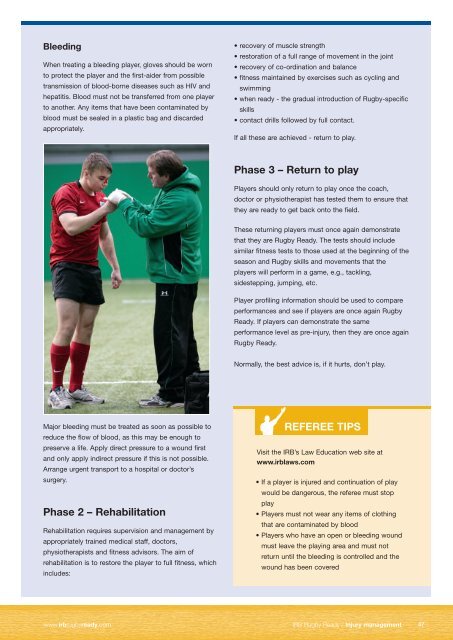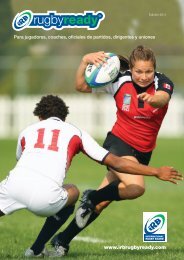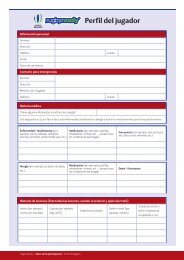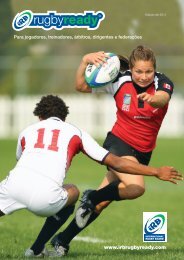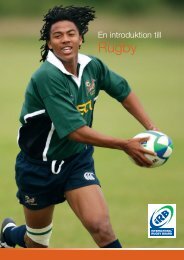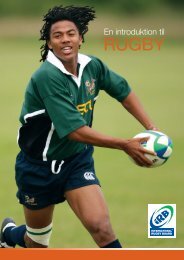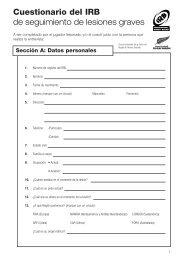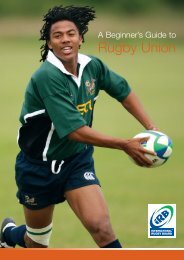IRB Beginner's Guide to Rugby - IRB Rugby Ready
IRB Beginner's Guide to Rugby - IRB Rugby Ready
IRB Beginner's Guide to Rugby - IRB Rugby Ready
You also want an ePaper? Increase the reach of your titles
YUMPU automatically turns print PDFs into web optimized ePapers that Google loves.
Bleeding<br />
When treating a bleeding player, gloves should be worn<br />
<strong>to</strong> protect the player and the first-aider from possible<br />
transmission of blood-borne diseases such as HIV and<br />
hepatitis. Blood must not be transferred from one player<br />
<strong>to</strong> another. Any items that have been contaminated by<br />
blood must be sealed in a plastic bag and discarded<br />
appropriately.<br />
• recovery of muscle strength<br />
• res<strong>to</strong>ration of a full range of movement in the joint<br />
• recovery of co-ordination and balance<br />
• fitness maintained by exercises such as cycling and<br />
swimming<br />
• when ready - the gradual introduction of <strong>Rugby</strong>-specific<br />
skills<br />
• contact drills followed by full contact.<br />
If all these are achieved - return <strong>to</strong> play.<br />
Phase 3 – Return <strong>to</strong> play<br />
Players should only return <strong>to</strong> play once the coach,<br />
doc<strong>to</strong>r or physiotherapist has tested them <strong>to</strong> ensure that<br />
they are ready <strong>to</strong> get back on<strong>to</strong> the field.<br />
These returning players must once again demonstrate<br />
that they are <strong>Rugby</strong> <strong>Ready</strong>. The tests should include<br />
similar fitness tests <strong>to</strong> those used at the beginning of the<br />
season and <strong>Rugby</strong> skills and movements that the<br />
players will perform in a game, e.g., tackling,<br />
sidestepping, jumping, etc.<br />
Player profiling information should be used <strong>to</strong> compare<br />
performances and see if players are once again <strong>Rugby</strong><br />
<strong>Ready</strong>. If players can demonstrate the same<br />
performance level as pre-injury, then they are once again<br />
<strong>Rugby</strong> <strong>Ready</strong>.<br />
Normally, the best advice is, if it hurts, don’t play.<br />
Major bleeding must be treated as soon as possible <strong>to</strong><br />
reduce the flow of blood, as this may be enough <strong>to</strong><br />
preserve a life. Apply direct pressure <strong>to</strong> a wound first<br />
and only apply indirect pressure if this is not possible.<br />
Arrange urgent transport <strong>to</strong> a hospital or doc<strong>to</strong>r’s<br />
surgery.<br />
Phase 2 – Rehabilitation<br />
Rehabilitation requires supervision and management by<br />
appropriately trained medical staff, doc<strong>to</strong>rs,<br />
physiotherapists and fitness advisors. The aim of<br />
rehabilitation is <strong>to</strong> res<strong>to</strong>re the player <strong>to</strong> full fitness, which<br />
includes:<br />
REFEREE TIPS<br />
Visit the <strong>IRB</strong>’s Law Education web site at<br />
www.irblaws.com<br />
• If a player is injured and continuation of play<br />
would be dangerous, the referee must s<strong>to</strong>p<br />
play<br />
• Players must not wear any items of clothing<br />
that are contaminated by blood<br />
• Players who have an open or bleeding wound<br />
must leave the playing area and must not<br />
return until the bleeding is controlled and the<br />
wound has been covered<br />
www.irbrugbyready.com<br />
<strong>IRB</strong> <strong>Rugby</strong> <strong>Ready</strong> / Injury management<br />
57


